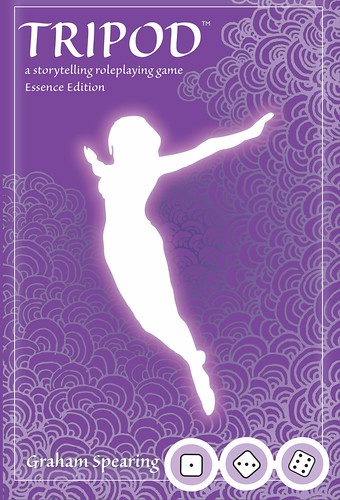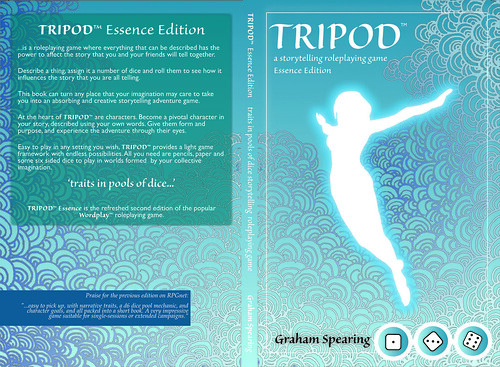 |
| The final front cover |
Longer ago than I'd like to think, Graham Spearing (First Age) invited me to take part in a playtest of a narrative storytelling roleplaying game which I instantly loved. The nature of the mechanics were free flowing and although you could have a powerful character, the use of a dice pool meant that you knew you could also be vulnerable. The engine isn't as swingy as the Year Zero Engine, but it can have definitely have highs and lows. I agreed to do the layout for the game, using Adobe InDesign. It was a learning experience and at the end of it I'd got moderately competent using the desktop publishing software. The final, definitive version was released in 2014, sporting a beautiful abstract cover by Stephanie McAlea. It was about 150 pages long and had hardcover and softcover versions.
Graham started musing about a shortened 'essence' edition a few years ago. One of the attractions of the original release was the voice that it had, but that made it longer than it needed to be. While working on it, he started to streamline the rules, and eventually it was becoming Wordplay 2. Ultimately, the game was renamed to TRIPOD (a play on 'traits in pools of dice') because Wordplay struggled to appear in searches and a lot of people assumed it was something other than a roleplaying game.
As development came to an end, I'd reached a point where I couldn't viably run InDesign anymore and I wasn't ready to pay for a Creative Suite subscription. Instead, I got hold of Affinity Publisher, resigning myself to having to recreate the look and feel from scratch. Graham wanted to show the Wordplay DNA with a similar layout.
 |
| The format, imported into Affinity Publisher. |
Publisher was developing quickly and soon gained the ability to import an IDML file. I used my old Mac to do this, and the import was perfect. Styles were preserved, as were the master pages. The only fly-in-the-ointment was that Publisher had no equivalent of the book file. In InDesign, you can have an overall book file which draws in independent chapter files for layout and allows you to merge at the end. Instead, I took a chapter file and built out from there so the book had a flat, single-file structure.
The Publisher Workbook and help files meant that I could quickly learn how to do things and get work underway. I had Google Docs open on the laptop screen and Affinity full screen on a monitor; cutting and pasting ensued. The trickiest things were tables. The original ones pulled through, but creating new ones well took a few attempts.
 |
| TRIPOD's cover done in the original Wordplay blue |
 |
| Purple mock up. |
Once we agreed that purple was the way to go, we needed to get the cover file from DriveThruRPG. Looking at this confirmed that the spine needed to go as the book was now too thin.
 |
| Cover design in Affinity Designer |
This was reasonably simple, as I was working with vector graphics. I had to select the right areas and drop them on the cover document. I put them on another layer to the template so I could play with visibility of items to bring them through. Mainly, I was switching off the purple rectangle in the background.
 |
| Bleed settings |
The final hurdle was getting the core text right. I added enough pages to make it a multiple of 6-pages (otherwise Lightning Source add the extras themselves without our control). We had a bit of a fumble until we got the bleed set right, but once that was done everything went forward into clearance. A day or so later it was signed off and Graham ordered the proof.
I'm sitting here hoping that it looks as good printed as it does on the screen, and I'm pretty confident that I can work my way around Publisher now. The MacBook (with a M1 Pro chip) handled the file speedily and without issue, which was great. I'll wait and see if any tweaks are needed, but in the meantime I've at least one long delayed project that I'd like to get laid out.
4 August 2022
No comments:
Post a Comment